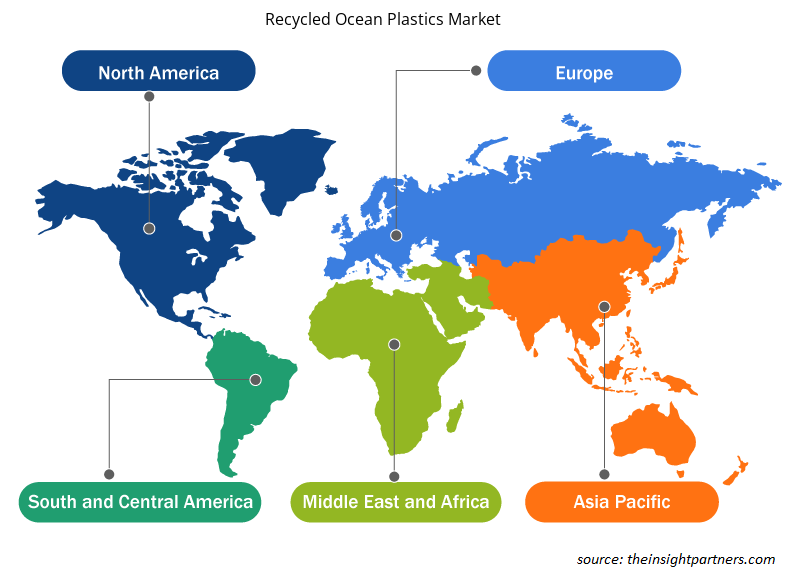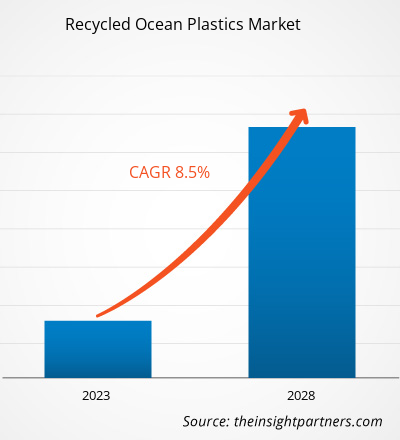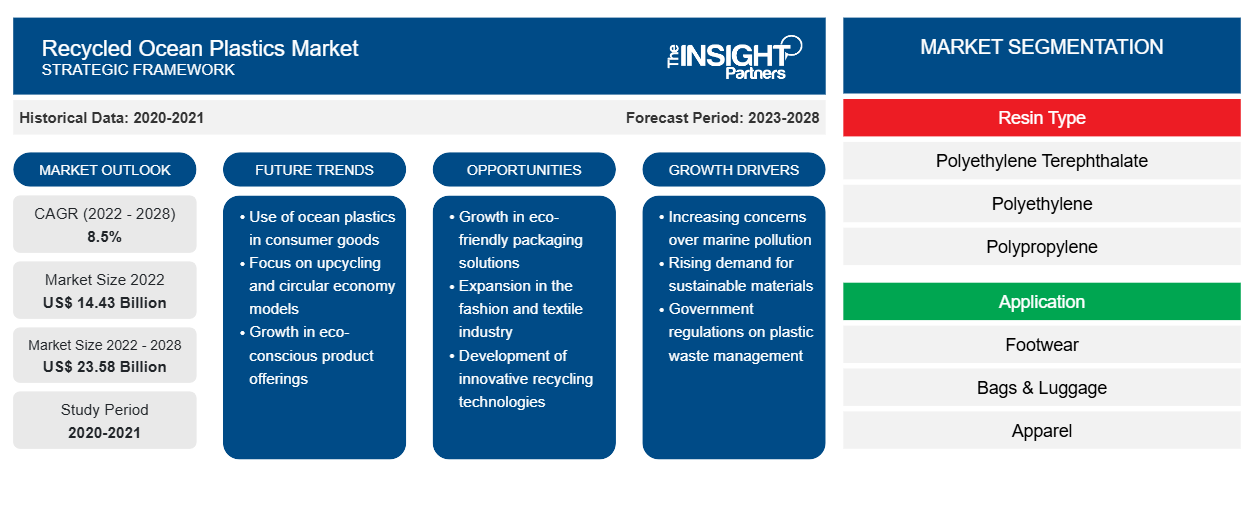2022 年再生海洋塑料市场规模价值为 144.3291 亿美元,预计 2022 年至 2028 年的复合年增长率为 8.5%。CAGR of 8.5% from 2022 to 2028.
塑料污染是主要问题之一,因为它对生物体有不利影响。每年都有大量塑料垃圾被倾倒到海洋和水道中,破坏了海洋生态系统。因此,制造商非常重视回收海洋塑料垃圾,并利用这些塑料生产有用的产品,如鞋类、袋子、行李箱、钱包和衣服。
2021 年,亚太地区占据了全球再生海洋塑料市场的最大收入份额。亚太地区的市场分为印度、中国、澳大利亚、日本、韩国和亚太地区其他地区。该地区再生海洋塑料市场的增长受到快速扩张的时尚产业、不断增长的人口以及该地区消费者对可持续解决方案的认识不断提高的推动。中国和印度是人口增长最快的国家之一。由于人口不断增长,该地区的鞋类、包装和建筑行业正在迅速发展。区域制造商通过生产环保产品减少碳足迹的举措日益增多,也推动了该地区再生海洋塑料市场的增长。eco-friendly products also fuel the recycled ocean plastics market growth in the region.
定制此报告以满足您的需求
您可以免费定制任何报告,包括本报告的部分内容、国家级分析、Excel 数据包,以及为初创企业和大学提供优惠和折扣
-
获取此报告的关键市场趋势。这个免费样品将包括数据分析,从市场趋势到估计和预测。
COVID-19 疫情对海洋塑料再生利用市场的影响
在 COVID-19 疫情爆发之前,鞋类、服装、包装和建筑行业对可持续和环保材料的需求不断增长,推动了对再生海洋塑料的需求。然而,在 2020 年,各国政府实施封锁以控制 SARS-CoV-2 感染的蔓延,导致塑料回收单位停止运营,造成再生海洋塑料短缺。根据 GA Circular 发布的一份报告,印度、越南和菲律宾 80% 的回收单位在 2020 年初关闭,导致再生塑料严重短缺。这对再生海洋塑料市场的增长产生了不利影响。
2021年,许多经济体恢复了运营。各国政府放宽了先前实施的限制,允许制造商满负荷运转。这一因素对塑料回收活动产生了积极影响。许多政府和非政府组织正在建设强大的废物管理基础设施,以支持循环经济并最大限度地减少塑料废物对海洋生态系统的威胁。这一因素将在预测期内推动对再生海洋塑料的需求。
市场洞察
越来越多地推出由回收海洋塑料制成的产品
塑料污染是一个紧迫的全球挑战,因为它对生物构成了重大威胁。根据联合国教育、科学及文化组织海洋素养门户网站提供的统计数据,塑料废物约占海洋污染总量的 80%,每年约有 800-1000 万公吨 (MMT) 的塑料流入海洋。此外,预计未来海洋中的微塑料量将大幅增加。尽管如此,许多国家对海洋塑料污染的认识有所提高,政府和监管机构正在采取措施回收这些塑料。许多公司正在推出创新且有吸引力的产品,如鞋类、手提包和钱包、太阳镜和服装,使用回收的海洋塑料来实现其可持续发展目标并减少其整体环境足迹。所有这些因素都推动了回收海洋塑料市场的增长。
树脂类型洞察
根据树脂类型,全球再生海洋塑料市场细分为聚对苯二甲酸乙二醇酯 (PET)、聚乙烯 (PE)、聚丙烯 (PP)、聚苯乙烯 (PS) 等。2021 年,聚对苯二甲酸乙二醇酯细分市场占据了最大的市场份额。由于聚对苯二甲酸乙二醇酯 (PET) 重量较重且能够保持形状,因此很容易从海洋和水道中提取,这促进了该细分市场的市场增长。此外,箱包和鞋类应用对再生海洋 PET 的需求不断增长也推动了该地区市场的增长。
应用程序洞察
根据应用,全球再生海洋塑料市场细分为鞋类、箱包、服装、建筑材料等。服装领域在 2021 年占据了最大的市场份额。时尚行业对服装的需求不断增长以及全球人口的增长预计将在未来几年推动纺织行业对再生海洋塑料的需求。
Aquafil SpA、BIONIC、Tide Ocean SA、Oceanworks、Textil Santanderina、Envision Plastics、OceanYarn、Waste2Wear、Unifi, Inc. 和 SABIC 是再生海洋塑料市场的参与者之一。这些公司正在对研发进行大量投资,以开发创新产品来满足新兴的消费者需求。市场参与者专注于提供高质量的产品以满足客户需求。
再生海洋塑料市场区域洞察
Insight Partners 的分析师已详细解释了预测期内影响再生海洋塑料市场的区域趋势和因素。本节还讨论了北美、欧洲、亚太地区、中东和非洲以及南美和中美洲的再生海洋塑料市场细分和地理位置。

- 获取再生海洋塑料市场的区域特定数据
再生海洋塑料市场报告范围
| 报告属性 | 细节 |
|---|---|
| 2022 年市场规模 | 144.3亿美元 |
| 2028 年市场规模 | 235.8亿美元 |
| 全球复合年增长率(2022 - 2028) | 8.5% |
| 史料 | 2020-2021 |
| 预测期 | 2023-2028 |
| 涵盖的领域 |
按树脂类型
|
| 覆盖地区和国家 |
北美
|
| 市场领导者和主要公司简介 |
|
再生海洋塑料市场参与者密度:了解其对业务动态的影响
再生海洋塑料市场正在快速增长,这得益于终端用户需求的不断增长,而这些需求又源于消费者偏好的不断变化、技术进步以及对产品优势的认识不断提高等因素。随着需求的增加,企业正在扩大其产品范围,进行创新以满足消费者的需求,并利用新兴趋势,从而进一步推动市场增长。
市场参与者密度是指在特定市场或行业内运营的企业或公司的分布情况。它表明在给定市场空间中,相对于其规模或总市场价值,有多少竞争对手(市场参与者)存在。
在再生海洋塑料市场运营的主要公司有:
- Aquafil 公司
- 仿生
- 潮汐海洋 SA
- 海洋工程
- 圣安德烈娜纺织公司
免责声明:上面列出的公司没有按照任何特定顺序排列。

- 了解再生海洋塑料市场的主要参与者概况
报告亮点
- 再生海洋塑料市场的渐进式行业趋势可帮助参与者制定有效的长期战略
- 发达市场和发展中市场采用的业务增长战略
- 2020 年至 2028 年再生海洋塑料市场的定量分析
- 全球对回收海洋塑料的需求估计
- 波特五力分析说明了行业内买家和供应商的效力
- 了解竞争市场状况的最新发展
- 市场趋势和前景以及推动和抑制再生海洋塑料市场增长的因素
- 通过强调支撑商业利益的市场策略来协助决策过程,从而推动海洋塑料再生市场的增长
- 不同节点的海洋塑料再生利用市场规模
- 市场详细概述和细分,以及再生海洋塑料行业动态
- 各地区海洋塑料再生利用市场规模及增长潜力
全球再生海洋塑料市场
全球再生海洋塑料市场按树脂类型分为聚对苯二甲酸乙二醇酯 (PET)、聚乙烯 (PE)、聚丙烯 (PP)、聚苯乙烯 (PS) 等。按应用,市场分为鞋类、箱包、服装、建筑材料等。
公司简介
- Aquafil 公司
- 仿生
- 潮汐海洋 SA
- 海洋工程
- 圣安德烈娜纺织公司
- 远景塑料
- 海洋纱
- 废物利用
- Unifi 公司
- 沙特基础工业公司
- 历史分析(2 年)、基准年、预测(7 年)及复合年增长率
- PEST和SWOT分析
- 市场规模、价值/数量 - 全球、区域、国家
- 行业和竞争格局
- Excel 数据集
近期报告
相关报告
客户评价
购买理由
- 明智的决策
- 了解市场动态
- 竞争分析
- 客户洞察
- 市场预测
- 风险规避
- 战略规划
- 投资论证
- 识别新兴市场
- 优化营销策略
- 提升运营效率
- 顺应监管趋势























 获取免费样品 - 再生海洋塑料市场
获取免费样品 - 再生海洋塑料市场